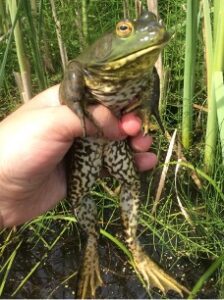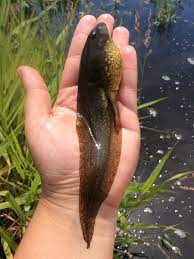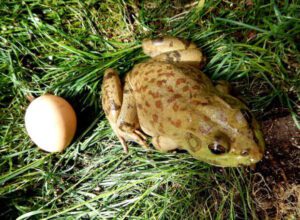WHAT IS AN AMERICAN BULLFROG?
- Introduced, invasive species in BC, with few local predators.
- Bullfrogs pose a serious risk to native amphibians, reptiles and waterfowl. They may eat ‘anything that fits in their mouths’ such as ducklings, turtles, and snakes.
- Once established, bullfrogs can significantly reduce biological diversity.
WHAT DO THEY LOOK LIKE?
- Very large, green or brown in colour, with large, golden eyes.
- Adult females can be 20 centimetres in length, not including legs. Males usually smaller.
- Both sexes have large, distinct tympanum (‘ear’) just behind and below the eye (see photos below). A male’s tympanum is roughly twice the size of the eye. On females, it is about the same size as the eye.
- Do not have raised lines along their backs (dorso-lateral ridges), only behind the eye.
- Adult males have bright yellow throats, and females have paler cream or white throats.
- See a Local Frog ID Guide by Peter Karsten HERE.
Adult Bullfrog (left) and Bullfrog tadpole (right). Photos A. Switzer.
WHY SHOULD I CARE ABOUT BULLFROGS ON DENMAN?
- In 2018 one American Bullfrog was found on Denman Island.
- Each year since 2018 we have received reports of unconfirmed sightings or callings.
- A 2022 professional survey of Chickadee Lake indicated that we likely don’t have an established breeding population on Denman yet, but all it takes is two bullfrogs and numbers can quickly jump into the thousands if allowed to reproduce.
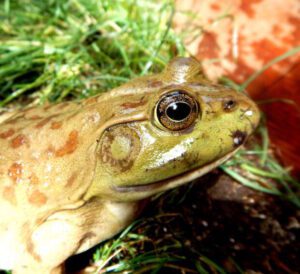
A female American Bullfrog found on Denman Island in 2018. Photos P. Karsten.
HOW MIGHT I FIND THEM?
- Bullfrogs live in wetlands, ponds & lakes where there is standing water all year. They seldom leave the water, unlike other native frog species.
- Male bullfrogs begin calling in the late spring and summer, (later than other frogs) when surface water temperatures rise to around 20℃. Their deep calls can carry up to a kilometre!
- Bullfrogs reproduce in mid-summer and each adult female will deposit tens of thousands of eggs. Each egg is tiny, black and will hatch in three to five days.
- Once hatched, tadpoles grow rapidly. They are up to 15cm long, very dark green in colour, and arrowhead-shaped with a dorsal fin that begins behind the body. They are very conspicuous in daylight and will crowd into the warmest water, usually shallow lake or wetland edges. Their large size distinguishes them from native species.
- Newly metamorphosed Bullfrogs are small compared to adults, but still as big as adults of other species.
- Adults may be floating just beneath the water’s surface with only their eyes and snout visible.
BE A DCA VOLUNTEER BULLFROG MONITOR!
LISTENING FOR BULLFROGS…
American Bullfrogs have a very distinctive, deep mating call. They call later in the year than our 2 native frog species, the Pacific Chorus Frog, and the Northern Red-Legged Frog. Male bullfrogs can be heard from late May to the end of September, but the peak mating season is June and July. They will call most often on warm evenings after warm sunny days, and can be heard from a kilometre away!
Click on the sound clips below to hear bullfrog calls versus native frog calls.[1]
American Bullfrog – Lithobates catesbeiana/Rana catesbeiana
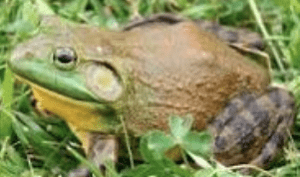
Pacific Chorus Frog – Pseudacris regilla
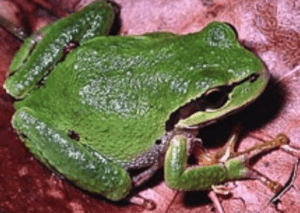
Northern Red-Legged Frog – Rana aurora
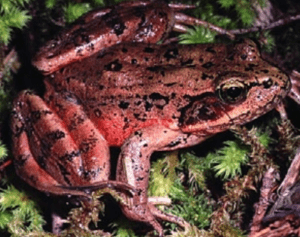
FOR MORE INFORMATION…
- Guide to BC Amphibians (Download 1.4MB)
- http://bullfrogcontrol.com/is_it_a_bullfrog_or_not.html
- Video about bullfrog control methods on Vancouver Island [WATCH].
- BC Government Amphibian Info
- BC Frogwatch: Ministry of Environment, Lands and Parks P.O. Box 9374 Stn Prov Govt, Victoria, B.C. V8W 9M4; email: bcfrogwatch@victoria1.gov.bc.ca
BE A DCA VOLUNTEER BULLFROG MONITOR!
DCA is grateful for funding support for this initiative from:

[1] Sound clips: https://www2.gov.bc.ca/gov/content/environment/plants-animals-ecosystems/wildlife/wildlife-conservation/amphibians-reptiles/amphibians-in-b-c/frogs-toads; http://www.californiaherps.com/frogs/pages/p.regilla.sounds.html

